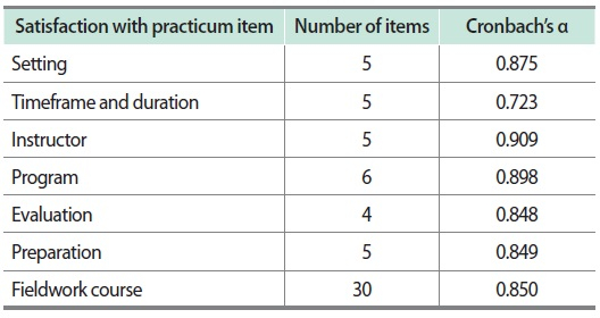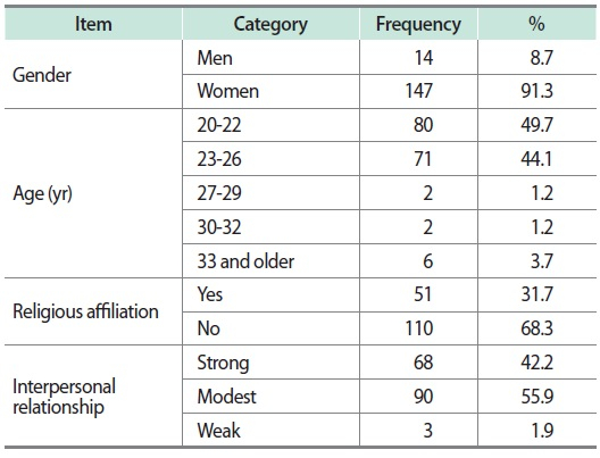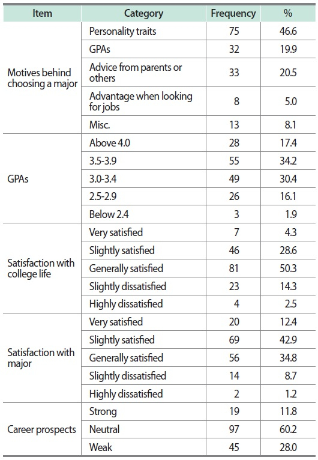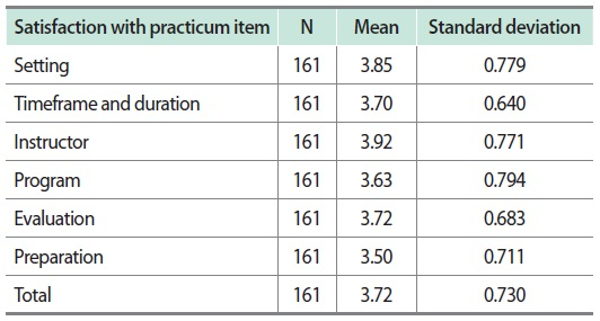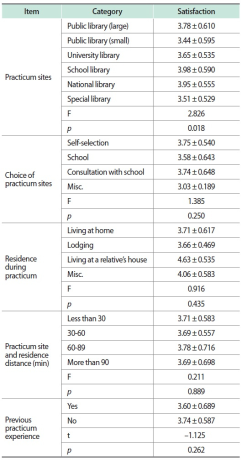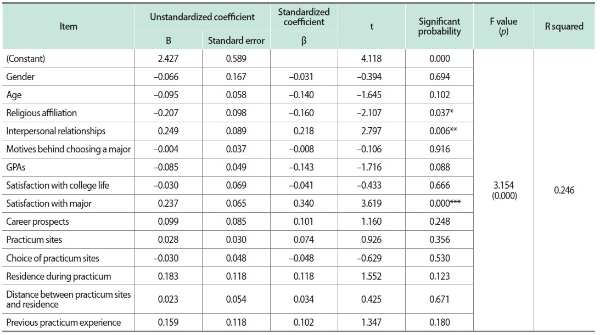JOURNAL OF INFORMATION SCIENCE THEORY AND PRACTICE
- 권한신청
- P-ISSN2287-9099
- E-ISSN2287-4577
- SCOPUS, KCI
Factors Influencing Student Satisfaction with the Fieldwork Course in LIS in South Korea

Kyung-Jae Bae (Department of Library and Information, Dongduk Women's University)

Abstract
This study attempts to draw the implications of student satisfaction with fieldwork courses in the library and information science (LIS) program in South Korea by determining the level of satisfaction experienced by students with practicums at a library and information service agency. LIS students with fieldwork experience were surveyed to assess their satisfaction and the factors affecting their satisfaction. Results from a multiple regression analysis revealed that from among factors of practicum settings, major-related attributes, and general attributes of respondents, “satisfaction with majors” and “interpersonal relationships” had a significant effect on satisfaction with practicums. Examining the six components of satisfaction with the course revealed that “practicum program” and “practicum setting” had a significant relationship with overall satisfaction. A selective intervention program to improve satisfaction with the course needs to be developed based on factors influencing overall satisfaction, focusing on “interpersonal relationship” and “satisfaction with majors.”
- keywords
- fieldwork course, student satisfaction with practicum, library and information science education, curriculum of practical training, library internship
1. INTRODUCTION
The curriculum of practical training is integral to library and information science (LIS) programs because the research findings can be implemented onsite at information service agencies and libraries. Fieldwork courses focus on the practical aspects of the LIS curriculum. Although there has been a change in the perception of their value with the theory vs. practice debate, fieldwork is now generally recognized as a crucial factor in the LIS program among LIS scholars (Ball, 2008).
Several terms for fieldwork courses have been used in LIS: practicum, practice work, practicum work, field experience, field work, field problems, internship, professional field experience, cooperative education, and work study (Futas, 1994; Mediavilla, 2006). The following definition of Coleman (1989) will be used in this study to gain a better understanding of the terminology “Fieldwork Course”:
-
A relatively short-term, professionally supervised work experience offered as part of the school’s curriculum and taken during the academic sequence. The practicum is typically pursued in the same library or information agency for the total experience. Other than incidental expenses, the practicum student does not receive a salary.
LIS is a field of study involving a variety of information-mediated subjects while serving as the heart of librarian training. By 2018, 40 universities in South Korea had established departments of library and information science, wherein students are awarded librarian certification upon graduation. Fieldwork courses in the LIS curriculums of most universities are designed to be completed before graduation.
The LIS fieldwork course is offered as part of the university’s curriculum on the library premises. Such structural characteristics of the course demand close industry-education cooperation between practicum sites and academia. Since the university curriculum of LIS training in South Korea is suffering substantial alienation from library practicum sites by focusing on theory rather than on practice, the fieldwork course has been a useful alternative to help reduce the gap between academics and practice.
Yet, despite its usefulness, its limitations based on its environment put the course in a challenging situation wherein its educational purpose is not effectively served. This is partially due to the gap between practice and education, a long-standing issue that has erupted at different times in LIS-related professions (Bird & Crumpton, 2014). There are concerns that such a gap between academics and practicum sites may cause confusion among students about library-related knowledge, compromising the effectiveness of practical training and leading to a drop in overall satisfaction with education. Ball (2008) has indicated that previous studies on LIS fieldwork courses have suffered from lack of comprehensive and rigorous research and survey data gathered regarding fieldwork. Therefore, an accurate understanding of the current status of the fieldwork course is required by collecting student opinion data from the practicum sites.
Despite the importance of fieldwork courses in LIS, the current LIS curriculum contents and process of practical training pursued at universities of South Korea have been designed mainly for the benefit of the supplier, such as its significance or interest to professors or educational institutions, rather than focusing on student perspectives. Notwithstanding this fact, this study aims to empirically examine student satisfaction with the LIS fieldwork practicum and its current status and draw implications from fieldwork course satisfaction. Based on this, it also analyzes factors affecting LIS student satisfaction with the practicum to seek out strategies for a more effective and satisfactory fieldwork course that can be pursued by universities and practicum sites as well as students.
To achieve this goal, the following research items were developed for this study.
First, this study investigates the degree of satisfaction expressed by LIS practicum students who had undergone fieldwork course at a library or an information service agency. A survey was conducted on LIS practicum participants and analyzed based on their general attributes, major-related attributes, practicum conditions, satisfaction with various aspects of the practicum (setting, timeframe and duration, instructor, program, evaluation, and preparation), and overall perception.
Second, this study explores how practicum-related elements such as general attributes, major-related attributes, and practicum conditions influence LIS student satisfaction with the practicum. Regression analysis was conducted (1) to identify factors affecting student satisfaction with the practicum specifically based on respondents’ general attributes, major-related attributes, and practicum conditions, and (2) to determine how they influence satisfaction.
Third, the six variables of practicum (setting, timeframe and duration, instructor, program, evaluation, and preparation) are examined to determine the overall satisfaction of respondents.
Fourth, this study aims to present the best practices of fieldwork courses conducted at libraries and information service agencies and to set the right direction for LIS students.
2. LITERATURE REVIEW
2.1. Variables of College Students’ Satisfaction with Curriculum
As Aharony (Aharony, 2011; Pryor, 1999) observes, “Assessing student satisfaction can play a major role in evaluating the effectiveness of learning” and proving the usefulness of learning programs. Various studies to assess student satisfaction and to prove the value of curriculums have been made. Also, several factors affecting satisfaction, such as participant attitude, knowledge and performance gains, and intentions to participate in a future program, have also been used in previous studies (Pryor, 1999). Aharony and Raban (2008) examined the attitudes of three stakeholder groups, including librarians, working-level officials, and the faculty, about incorporating a course on the economics of information goods into LIS curricula. In addition to examining faculty discussions and deliberations on a new course, students and practitioners’ attitudes were also taken into consideration.
The most frequently used variable, as a factor affecting student satisfaction, is associated with the quality of education programs (Hearn, 1985; Thomas & Galambos, 2004). Satisfaction with the quality of education offers an important comparison and highlights alternative consumer outcomes (Thomas & Galambos, 2004). Hearn (1985) suggested that, in general, stimulating coursework and good teaching were somewhat more important than opportunities for faculty/student interaction or perceived faculty knowledgeability.
Besides the variable involving the education program itself, that fact that personal disposition also influences learning remains a major concern (Cherry, Freund, & Duff, 2013). Cherry et al. (2013) in their research on Master of Library and Information Science students online found statistically significant differences in preferences and satisfaction across five demographic variables: age (generational cohort), employment status, urban status, commute distance, and program modality. Bean and Bradley (1986) conducted a study with students’ grade point averages (GPAs) to identify the satisfaction-performance relationship and found that the relationship between GPA and satisfaction is statistically significant only for women. Pike (1991) also examined the relationship between grades and satisfaction using a latent variable model. The results suggest that satisfaction exerts a stronger influence on grades than grades exert on satisfaction.
Studies also indicate that gender differences can be a personal variable affecting students’ learning experience. Marley (2007) in a literature review identified that gender-identity differences can affect student learning experiences at several different points within a distance education course, beginning with motivation for enrolling, and continuing on through communication styles within the class, use of technology, learning style, and even dropout or failure rates.
Overall, the results of literature review show that different variables such as education programs, personal disposition, academic performance, and attitudes of education program participants are found to have a significant influence on student satisfaction with curricula.
2.2. Research on LIS Fieldwork Course in South Korea
When developing a curriculum for the first department of library science at Columbia University in 1884, Melville Dewey stressed the importance of a library practicum in the curriculum, claiming that lectures and reading alone are simply insufficient to foster the best librarians; besides these actions, also required are educational activities such as seminars, field studies about success stories of libraries, and hands-on experience acquired from libraries (Grogan, 2007). Library practicums were highly regarded in early days but little attention was paid to them from the 1920s to the late 1960s, by treating them as vocational training. Rothsthein in 1968 asserted that it is necessary to reintroduce the library practicum curriculum into the education program for American librarians, to consolidate theoretical knowledge as well as application of theory to practice (Lynch, 2008). Over the next two decades, LIS scholars maintained that the library practicum should be incorporated as a meaningful subject into LIS curriculums in the United States. Hence, the curriculum of library practicums became an integral part of the LIS education course since the 1970s and has been competitively included in the LIS curriculum as a core subject since the 1990s.
In South Korea, the fieldwork course has been incorporated into the LIS curriculum as a core subject and research has been conducted mainly since the year 2000 focusing on the effects, status, and program strategy of fieldwork courses. Meanwhile, studies examining the perception and satisfaction of field course trainees have been limited.
Koo (1983), the first Korean scholar who investigated the practicum pursued in South Korea, examined practical training and its issues in library work on 16 LIS programs selected from 27 universities in 1983. He found that all participating LIS programs in his investigation implemented a library practicum, and among them, 11 programs require students to complete the practicum as a mandatory course. Subsequently, research on practicum program design has been steadily growing. Kim (2011) examined the contents of practical training for school teacher-librarians by conducting a survey on those who had completed their practicum and presented an education program based on their expertise, and proposed a practicum training program consisting of 28 elements. Jung (2011) argued that his journal feedback program based on the principle of journal and abstract writing showed a positive effect when applied in practice on the library practicum curriculum designed for librarian candidates.
Since 2010 there has been intensive research to identify the needs of stakeholders (library working-level officials, students, and faculty) in the LIS field course. Yoo (2012) conducted a job-shadowing internship program to minimize the challenges faced by LIS undergraduate students during their fieldwork courses and to lessen the burden of officials at practicum sites, which enabled her to explore interns’ perceptions of the fieldwork course’s effectiveness and the problems interns faced. Lee and Kim (2012) surveyed practical training programs in 42 town-level public libraries and the library practicum curriculum available in four-year LIS degree programs; they identified the demands of librarians at practicum sites and of practicum students on the training conducted by C University LIS students in S public library, and presented the challenges faced by education institutions, practicum agencies, and students, along with strategies for improvement. Yoo (2014) re-evaluated field training as part of an internship program by diagnosing problems perceived by working-level staff during the implementation of the program at their libraries, revealing that the staff in charge of interns have a positive opinion about the internship program but fail to recognize (or tend not to take it seriously) that they actually have a major influence on their interns during fieldwork. Therefore, the staff who lead practical training play a critical role in student satisfaction. Damasco and McGurr (2008) stated that to be successful, it is vital for a library training program to have librarian candidates convinced of their library practicum as a meaningful, well-coordinated experience, which suggests that the faculty and staff who systematically prepare and design the training program play a pivotal role.
To sum up, various studies on LIS fieldwork course have begun in South Korea since 2010, but they are mainly focused on the design and needs assessment of practical training programs, leaving the current research relatively insufficient to carry out a curriculum evaluation, especially from the perspective of the demander, that is, based on the assessment of student satisfaction with the practicum.
3. RESEARCH METHODOLOGY
3.1. Research Subjects and Data Collection Methods
A survey was conducted on 170 LIS students from eight universities, who had undergone the fieldwork course offered by a library and information service agency, to assess their satisfaction with the practicum.
The data for the self-administered survey were collected from September 29, 2018 through October 10, 2018, by means of a structured questionnaire. The study purpose was explained to the participants and their informed consent was obtained prior to the survey. After excluding respondents with missing or incomplete responses, 161 participants were selected.
3.1.1. Research tools
3.1.1.1. Factors Affecting LIS Student Satisfaction with Practicums
A new strategy is needed to improve the effectiveness of practicums based on the causal relationship between factors affecting fieldwork course effectiveness. Therefore, six assessment items were selected and factors based on previous findings from related studies were used to determine satisfaction of students who had completed their fieldwork course. Factors affecting satisfaction identified from student perceptions of a training program in information science in Canada, in research conducted by Cherry et al. (2013), were also used for this study as the foundation for factor selection. Cherry et al. (2013) investigated factors influencing the academic and intellectual environment, program content and structure, coursework, and facilities and services to determine student satisfaction. Considering these factors and consulting the variables extracted from previous findings, this study examines the effect of six factors as follows.
Practicum setting: A better practicum setting can enhance the effects of fieldwork courses because the surroundings, such as the atmosphere, staffing, library collection, and facility of the practicum site (library) are crucial.
Practicum timeframe and duration: Imposing a reasonable timeframe and duration on the fieldwork course can have a major impact on improving student satisfaction.
Practicum instructor: The qualities of a fieldwork instructor library work – such as he/she being a first-rate educator with effective leadership skills, high self-esteem and expertise, an enthusiastic attitude and integrity toward the course, and communication skills – can influence the effects of fieldwork course.
Practicum program: A well-structured practicum program has a profound impact on the effects of fieldwork courses; for example, a practicum program that delivers proper instructions and feedback on students’ assignments and practicum tasks, and provides accurate requirements and scope for understanding fieldwork as well as systematic training procedures including teaching methods, organization, and selection of training details to be learned by a trainee during the course.
Practicum evaluation: A fieldwork practicum is usually a credit course and thus objective and fair evaluation prepared and applied through an adequate evaluation system across the curriculum has a positive influence on the effects of the course.
Practicum preparation: It refers to the tasks of main entities such as leadership at the practicum site, the supervisor, and the trainee engaged in the fieldwork courses. Trainees choose a suitable practicum site and prepare themselves for the practicum through prior consultation with their supervisor about the types of practical training available for them, while the supervisor provides the full scope of instructions through an orientation for students regarding the contents and processes they will go through during the course. The leadership prepares the contents and processes to be imparted onsite in a systematic manner to provide proper guidance at an early stage of practicum. With these in place, the effects of the fieldwork course can be greatly enhanced.
3.1.1.2. Survey Questionnaire Construction
Using preliminary analysis and literature review, a questionnaire was designed with 46 items in all with subsections consisting of 4 items for general attributes, 6 items for major-related attributes, 5 items for practicum conditions, and 31 items for satisfaction with the practicum. Questions pertaining to satisfaction with the practicum again include 5 items each for satisfaction with the practicum setting, practicum timeframe and duration, and practicum instructor; 6 items for satisfaction with the practicum program, 4 for satisfaction with practicum evaluation, 5 for satisfaction with practicum preparation, and 1 for overall satisfaction. A 5-point Likert scale was used to assess the levels of student satisfaction in the items pertaining to satisfaction with the practicum, with 1 signifying “Not at all” and 5 signifying “Very Satisfied.”
3.2. Data Analysis and Reliability Evaluation
For interpreting the survey results on the LIS fieldwork course, statistics software (SPSS 22.0) was used for regression analysis, cross validation, descriptive statistics, and frequency analysis.
Cronbach’s α was used to test the reliability of the research tool (questionnaire). The results showed that the overall confidence coefficient is larger than 0.6 whereas the confidence coefficient for student satisfaction with the practicum is 0.850; therefore, the questionnaire as a research tool showed internal consistency. Table 1 shows the results of the reliability test.
3.3. Measurements of Satisfaction with Fieldwork Course
3.3.1. General Attributes of Respondents
The demographic characteristics of the respondents who participated in this survey on satisfaction with LIS fieldwork courses are as follows: 8.7 percent (14 respondents) are men and 91.3 percent (147 respondents) are women. The age distribution of the respondents shows that 49.7 percent (80) are aged between 20 and 22, 44.1 percent (71) are between 23 and 26, 1.2 percent (2) are between 27 and 29, 1.2 percent (2) are between 30 and 32, and 3.7 percent (6) are aged 33 and older, which indicates that the majority of survey participants are female college students in their early 20s. Furthermore, respondents with a religious affiliation number 31.7 percent (51) whereas those with no religious affiliation are at 68.3 percent (110), which is more than twice the number of those with a religious affiliation. Regarding interpersonal relationships, 42.2 percent (68) of the respondents answered “Strong,” 55.9 percent (90) answered “Modest,” and 1.9 percent (3) answered “Weak,” which shows that most respondents consider their interpersonal relationships to be above average. Table 2 shows further details. In this study, ‘religious affiliation’ was added specifically as a component of the general characteristics of the respondents. The reason why the general attributes of the respondents include ‘religious affiliation’ is that it is a factor affecting the psychological and human relations aspects of the individual, which can affect the satisfaction of the field practice.
The analytical results of the demographic characteristics of the respondents were found to exhibit a typical pattern among LIS students in South Korea, characterized by a high percentage of women college students. The results are expected to be sufficient to represent the population group.
3.3.2. Analysis of Major-related Attributes
For motives behind choosing a major, a majority of respondents, 46.6 percent (75), answered they selected their major based on “personality traits (aptitude),” while 19.9 percent (32) of respondents answered based on “GPAs,” 20.5 percent (33) based on “advice from parents or others,” and 5.0 percent (8) based on “advantage offered when looking for a job.” On the point regarding student satisfaction with college life, 50.3 percent (81) of the respondents marked “Generally Satisfied” while 28.6 percent (46) marked “Slightly Satisfied.” Regarding student satisfaction with majors, 42.9 percent (69) of respondents marked “Slightly Satisfied” while 34.8 percent (56) marked “Generally Satisfied.” This indicates that, overall, the survey respondents were satisfied with their college life and major to a considerable extent. On the contrary, 60.2 percent (97) of the respondents were “Neutral” and 28.0 percent (45) marked “Weak” about career prospects, which indicates that a majority of the respondents had a neutral or grim perception about job prospects. Table 3 shows further details.
3.3.3. Analysis of Practicum Setting Attributes
Among the respondents, 47.2 percent (76) and 20.5 percent (33) did their practicums at large and small public libraries, respectively, with 9.3 percent (15) at the national library and 9.3 percent (15) at the university library. Choice of sites (library) largely depends on consultation with schools; 45.3 percent (73) of respondents chose their practicum sites using school-based consultation services, while the rest, 39.1 percent (63) and 14.3 percent (23), chose the sites by themselves or were recommended by the schools they were then attending. In addition, the commute distance (in minutes) between practicum site and residence is 30 to 59 minutes for 40.4 percent (65), less than 30 minutes for 31.7 percent (51), and 60 to 89 minutes for 21.7 percent (35). Regarding previous practicum experience, 82 percent (132) of the respondents said “No” compared to only 18 percent (29) of those who said “Yes,” which indicates that most respondents had no previous experience with library practicums prior to this field course. Table 4 shows further details.
3.3.4. Analysis of Satisfaction with Fieldwork Course by Components of Practicum
Among the six components for which respondents rated their satisfaction with the fieldwork course, overall satisfaction with the fieldwork course appears to be 3.72 across all items; satisfaction with the practicum instructor is 3.92, which is the highest among the components, and satisfaction with practicum preparation is 3.50, which is the lowest. However, satisfaction with the fieldwork course shows no significant difference among the six components. Table 5 shows further details of respondents’ satisfaction with the fieldwork course by each component.
3.3.5. Analysis of Satisfaction with Fieldwork Course Based on Respondents’ General Attributes
Men respondents showed a slightly higher satisfaction with the fieldwork course and those aged 20 to 22 exhibited the highest satisfaction (3.78), with no statistically significant differences in age and gender. In contrast, satisfaction of trainees with a religious affiliation (3.85) was found to be higher than that of those without a religious affiliation (3.65), at the significance level, and satisfaction of trainees with strong interpersonal relationships (3.90) was found to be higher than that of those with modest or weak interpersonal relationships, indicating a significant difference in student satisfaction with the practicum depending on different levels of interpersonal relationships. Table 6 shows further details of student satisfaction with the fieldwork course based on respondents’ general attributes.
3.3.6. Analysis of Satisfaction with Fieldwork Course Based on Major-related Attributes
In the analysis of student satisfaction with the fieldwork course based on respondents’ majors, trainees who answered “Very Satisfied” (4.06) appeared to be higher in number than those who said “Slightly Satisfied,” “Generally Satisfied,” and “Dissatisfied.” With regard to career prospects, trainees who marked satisfaction as “Strong” (3.93) turned out to be higher in number than those who marked “Neutral” or “Weak,” which indicates a significant difference in student satisfaction with the practicum, at a significance level of 0.01, according to the different career prospects and satisfaction with the major. Furthermore, student satisfaction with college life shows a somewhat significant difference, at a significance level of 0.05, in satisfaction with the practicum, though not considerably higher. Table 7 shows further details of student satisfaction based on their major.
3.3.7. Analysis of Satisfaction with Fieldwork Course Based on Practicum Setting
In the analysis of student satisfaction with the fieldwork course based on practicum setting, no significant difference was found between the attributes such as choice of practicum site, residence during practicum, distance between practicum site and residence (minutes), and previous practicum experience. However, self-selection (3.75) when choosing a practicum site appeared to give more satisfaction than when choosing a site depending on trainees’ schools, consultation with school, and so on. With regard to the practicum site, trainees showed higher satisfaction in the order of school library (3.98) and national library (3.95), indicating a significant difference in satisfaction with the fieldwork course based on different practicum sites, at a significance level of 0.05. Table 8 shows further details about respondents’ satisfaction with the course based on the practicum setting.
3.3.8. Analysis of Factors Affecting Satisfaction with Fieldwork Course
A multiple regression analysis was performed by setting the mean of satisfaction with the fieldwork course as a dependent variable and using inputs such as each factor of the practicum setting, major-related attributes, and general attributes as independent variables to determine the factors affecting satisfaction with the fieldwork course according to respondents’ general attributes, major-related attributes, and different practicum settings, and to reveal the extent to which they influence satisfaction. In the multiple regression model, factors such as satisfaction with major (standardized regression coefficient = 0.340) and interpersonal relationship (standardized regression coefficient = 0.218) were found to influence student satisfaction with the fieldwork course at a significance level of 0.01, along with the religious affiliation factor (standardized regression coefficient = –0.160) at a significance level of 0.05. As a result, the estimated regression coefficient for practicum students’ satisfaction with the major is 0.340, and those showing higher satisfaction with their majors were shown to have an increase in satisfaction with the fieldwork course by 0.34 points. Table 9 shows further details about factors affecting student satisfaction with the fieldwork course.
3.3.9. Comparison of Influences on Overall Satisfaction among the Components of Satisfaction with Practicum
A multiple regression analysis was performed by setting overall satisfaction as a dependent variable and using its six components (practicum setting, practicum timeframe and duration, practicum instructor, practicum program, practicum evaluation, and practicum preparation) as independent variables to identify factors affecting the overall satisfaction of respondents and their effects. In the multiple regression model, after excluding the four factors, practicum timeframe and duration, practicum instructor, practicum evaluation, and practicum preparation, the remaining two, practicum setting and practicum program, were adopted as significant variables at a significance level of 0.05, indicating that they have significant effects on overall satisfaction with the fieldwork course. Therefore, among the six components of the overall satisfaction with the fieldwork course, practicum program (standardized coefficient = 0.362) and practicum setting (standardized coefficient = 0.214) were found to have an influence on overall satisfaction. Table 10 shows further details about effects of components of satisfaction with practicum on overall satisfaction.
4. DISCUSSION
4.1. Analysis of Satisfaction with Fieldwork Course
LIS students need the preparation that enables them to apply LIS knowledge to practice through fieldwork courses. Therefore, efforts are needed to support their successful adaptation to field courses as well as to increase their satisfaction. This requires an understanding of factors affecting their satisfaction with the fieldwork course to lay the groundwork and provide baseline data for improving satisfaction.
In the overall satisfaction with the fieldwork course, the factor registering the highest satisfaction with respondents was the practicum instructor (mean 3.92), whereas “satisfaction with practicum preparation” scored relatively low (mean 3.50). This reflects on the relative excellence of library fieldwork instructors. However, this suggests the need for further substantial preparation for fieldwork courses at the school, practicum site, and trainee levels. Yet, no significant difference was observed in the mean of satisfaction among the six components.
4.2. Differences of Satisfaction Based on General Attributes
Despite no significant differences seen in LIS student satisfaction with the fieldwork course by gender and age, respondents with an religious affiliation were found to have higher levels of satisfaction at a statistically significant level, and satisfaction of trainees with strong interpersonal relationships appeared to be the highest, which shows a statistically significant difference in satisfaction with the practicum based on differences in religious affiliation and interpersonal relationships. These may indicate that satisfaction is influenced by the psychological and interpersonal aspects of the trainees to some extent. Therefore, practicum preparation in the future needs careful consideration of trainees’ psychological and interpersonal aspects to enhance satisfaction with the fieldwork course.
4.3. Differences in Satisfaction Based on Major-related Attributes
There was no significant difference seen in satisfaction with the fieldwork course according to LIS student majors and factors such as the motives for choosing the major and the grade acquired. In contrast, satisfaction with majors among trainees who were very satisfied with their LIS major was found to be high at a statistically significant level, and satisfaction of trainees with positive career prospects was higher than that of those with negative or neutral prospects. This reflected a statistically significant difference in satisfaction with the fieldwork course based on different career prospects and satisfaction with majors. These conclusions suggest that trainees satisfied with the LIS major and with positive career prospects in turn eventually show satisfaction with the fieldwork course. Therefore, more proactive efforts are needed to make trainees feel a sense of pride in their majors so that their overall satisfaction with the practicum improves.
4.4. Differences in Satisfaction Based on Practicum Setting
No significant difference was observed in LIS student satisfaction with the fieldwork course among factors such as choice of practicum site (library), residence during practicum, distance (in minutes) between practicum site and residence, and previous practicum experience, but trainees who chose the national library or school library as their practicum site showed a relatively higher level of satisfaction. The practicum site selected by a trainee based on familiarity or preference served as a positive factor for enhanced satisfaction. Therefore, vigorous efforts are needed when allocating practicum sites for future fieldwork courses to ensure that trainees can choose a library that is familiar to them or is one they prefer.
4.5. Factors Affecting Satisfaction with Fieldwork Courses
A multiple regression analysis was performed to determine the factors that affect satisfaction with the practicum from among the practicum setting, major-related attributes, and general attributes of LIS students. The results showed that such factors as religious affiliation (β = -0.160) at a significance level of 0.05, satisfaction with majors (β = 0.340), and interpersonal relationships (β = 0.218) at a significance level of 0.01 were found to have a statistically significant influence on satisfaction with fieldwork courses. This suggests that psychological and interpersonal aspects in education and student-oriented education in college majors to develop an interest in LIS majors should be reinforced to increase student satisfaction with the practicum.
4.6. Factors Affecting Overall Satisfaction among Components of Satisfaction with Practicums
Overall satisfaction with the fieldwork course was measured using six variables in this study. Among the six components of the practicum (setting, timeframe and duration, instructor, program, evaluation, and preparation), four variables were excluded and only two variables “practicum program (β = 0.362)” and “practicum setting (β = 0.214)” were found to have a statistically significant influence on overall satisfaction. This suggests that a trainee having relatively high satisfaction with the practicum setting tends to have a higher overall satisfaction with the fieldwork course, which is also applicable in the case of high satisfaction with fieldwork course programs because of their systematic and organized manner of functioning, as well as the appropriate design and scope of the course.
The results indicate that strategies for improving satisfaction with practicums in the future include focusing on the “practicum program” and “practicum setting,” to enhance the effectiveness of the LIS fieldwork course by improving satisfaction with the fieldwork course.
5. CONCLUSION
This study was conducted to seek strategies to make fieldwork courses more effective and satisfactory for students, practicum agencies, and colleges by examining the factors influencing LIS student satisfaction with the fieldwork course and their interrelationships. This will allow for an accurate diagnosis of problems and challenges faced in fieldwork management and methods, and will eventually contribute to planning practicum programs and approaches to improve the effectiveness of the course such that it can provide practical support for future LIS students in building their careers. This paper proposes an improvement strategy in the library fieldwork course for students participating in it through a discussion of the analytical results of factors affecting overall student satisfaction with the practicum. It also analyzed the differences in satisfaction depending on practicum setting, general attributes, and satisfaction with the fieldwork course.
First, from students’ overall satisfaction with the fieldwork course, satisfaction with the practicum instructor is highest whereas satisfaction with practicum preparation is relatively low from among the six factors of the practicum affecting satisfaction. Therefore, a more substantial preparation for fieldwork courses should be made at the level of the trainee, practicum site, and college in the future to systemize the pre-training orientation provided for trainees. These improvements can be achieved by developing and reflecting on detailed guidelines of LIS practical training. The following items should be clearly specified: practicum instruction guidelines and tools, relationships with educational institutions, teaching methods for practicums, contents of practicums, practicum processes, training time, the number of trainees, criteria for practicum instructors, criteria for practicum agencies, goals of practicums, and purposes of fieldwork course education.
Second, religious affiliation and interpersonal relationships of the college students are factors affecting student satisfaction with the fieldwork course, indicating that psychological and interpersonal aspects of trainees are also to be considered. Therefore, it is necessary to develop a model for LIS practical training curriculums that includes design of the practicum program, placement of practicum instructors, implementation of pre-training orientation, and student counseling services to foster healthy interpersonal relationships and promote student health and stability by carefully considering the psychological and interpersonal aspects of trainees.
Third, satisfaction with the LIS major among the participants appears to have a positive effect on their satisfaction with the fieldwork course, along with positive career prospects. Therefore, schools need to make a more proactive effort, for example, in introducing a student-oriented intensive education program for majors, dividing students of the same major into small groups for better communication among them, and implementing extracurricular programs to enhance students’ sense of pride in the majors they have chosen.
Fourth, there is a significant difference in satisfaction with the fieldwork course based on the practicum site the student has chosen, suggesting that familiarity with the site or a preference for a particular site is a positive factor for gaining satisfaction. Therefore, schools need to analyze the location and type of libraries during the selection process of practicum sites when liaising with sites for their fieldwork course by choosing the ones that are highly preferred by or are familiar to students.
Fifth, the six components of overall satisfaction with fieldwork courses and their interrelationships were examined, from which only two variables, the “practicum program” and “practicum setting,” were found to have a significant influence on overall satisfaction. This indicates that trainees showed higher levels of satisfaction with the practicum setting or with a well-organized fieldwork course offered by a practicum site, resulting in increased overall satisfaction with the LIS fieldwork course. Therefore, it is necessary to have an improvement strategy for satisfaction with practicums by focusing on a strategy that will enhance the “practicum program” and “practicum setting” to improve the educational effects of LIS fieldwork courses. To do this, practical training agencies need to develop a well-structured practical training program, determine its appropriate scope, and implement the fieldwork course in a systematic manner. At the same time, efforts should be made to increase satisfaction with the “practicum setting” by equipping practicum sites with the relevant infrastructure to successfully conduct fieldwork courses and create a cordial and interactive atmosphere in fieldwork education.
References
The practicum in collection development: A debate. In P. Johnson, & S. S. Intner (Eds.), Recruiting, educating and training librarians for collection development () ((1994)) Westport: Greenwood Press Futas, L. (1994). The practicum in collection development: A debate. In P. Johnson, & S. S. Intner (Eds.), Recruiting, educating and training librarians for collection development (pp. 145-156). Westport: Greenwood Press. , pp. 145-156
- 투고일Submission Date
- 2019-11-04
- 수정일Revised Date
- 게재확정일Accepted Date
- 2020-04-06
- 다운로드 수
- 조회수
- 0KCI 피인용수
- 0WOS 피인용수

